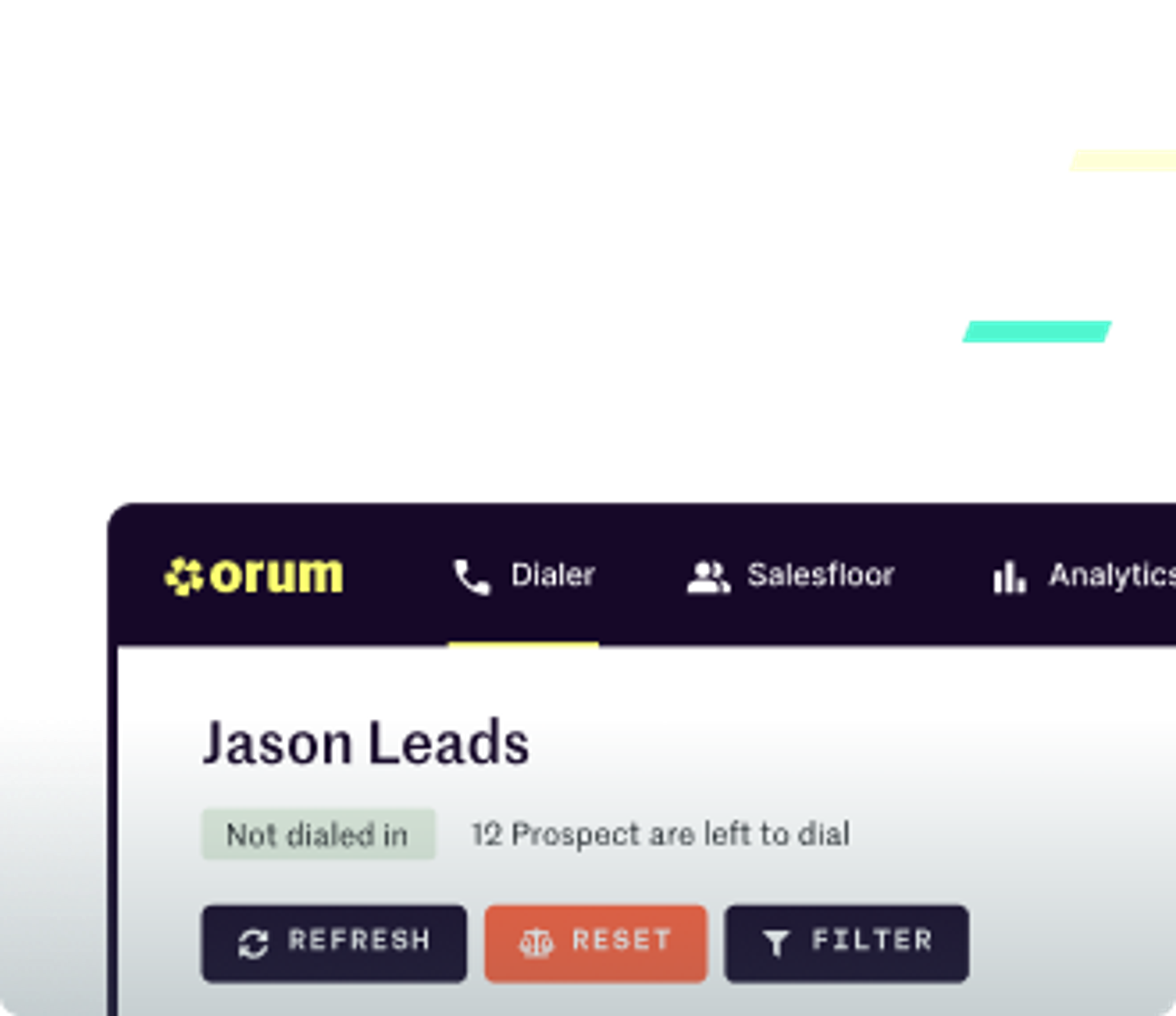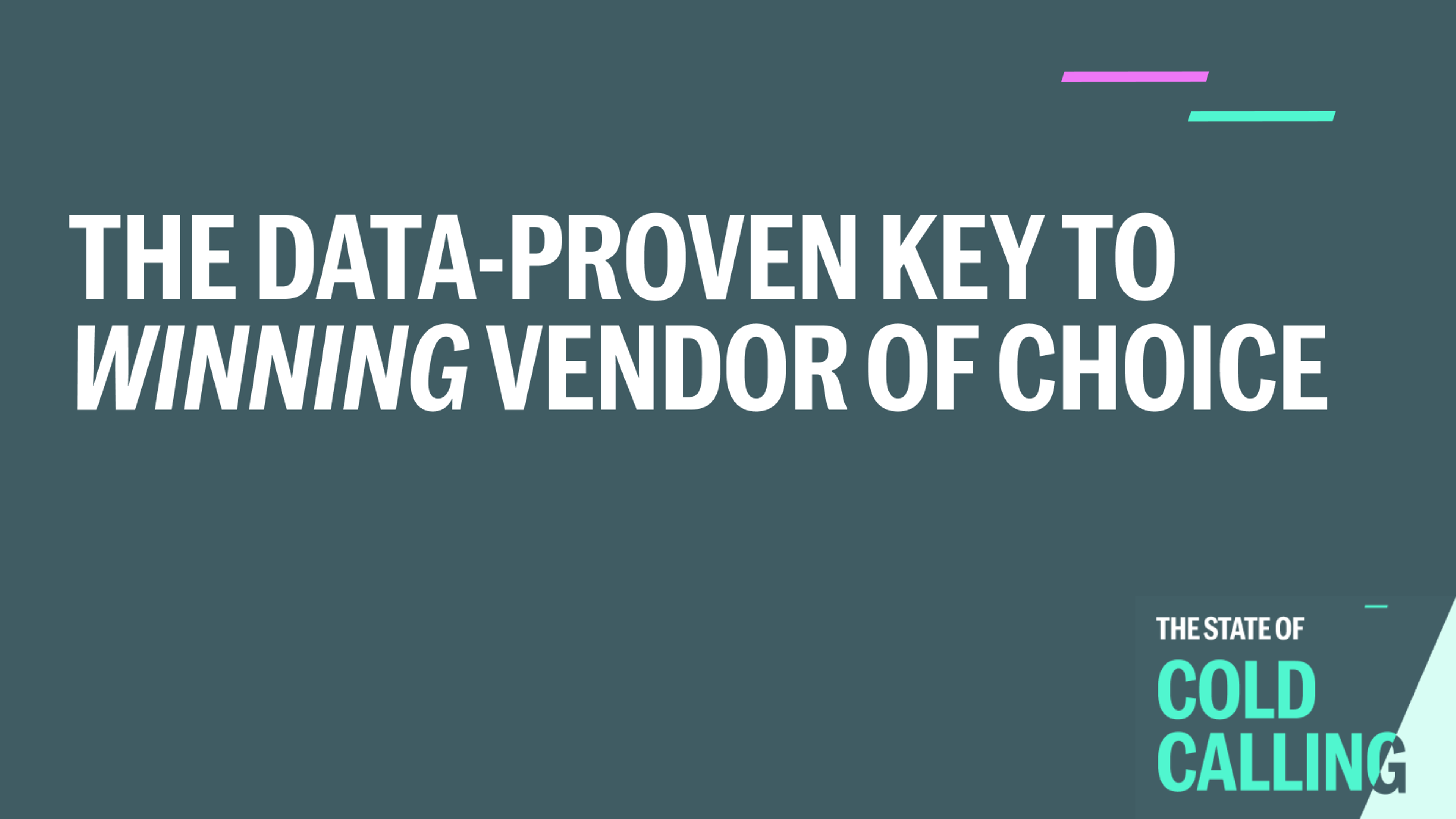How AI-Powered Dialers Impact Cold Calling & Increase Your Pipeline


Reps waste hours dialing bad numbers, leaving voicemails, and handling manual admin work instead of having actual conversations with your ICP. Without the right approach, outreach is inconsistent, low-converting, and difficult to optimize.
This article will guide you through the AI-powered solution.
You’ll see how AI cold calling helps sales teams connect faster and improve performance, covering:
- A 3-step process for implementing AI in outbound sales—from choosing the right dialer to CRM integration
- Best practices for balancing automation with personalization—including how to use AI for coaching and strategy development
- A real-world case study on how a B2B fintech company improved sales productivity and pipeline growth with AI cold calling
By the end, you’ll have a clear, actionable strategy to make AI work for your sales team—without losing the human touch.
Use AI to increase pick-up rates, automate tasks, and enhance call quality.
Get your reps into more conversations with Orum’s AI dialing platform.
How AI-powered cold calling improves sales performance
AI-powered cold calling isn’t just about automating dials—it’s about maximizing connections, refining outreach, and making data-driven decisions. Here’s how AI enhances sales performance while keeping reps focused on closing deals.
Improve connect rates and reduce wasted dials
Traditional cold calling means endless unanswered calls and time spent on bad prospects. AI-powered dialers change that:
- Eliminate wasted dials by skipping bad numbers and filtering out voicemails
- Optimize timing so calls happen when prospects are most likely to answer
- Prioritize high-intent leads based on CRM data
Reps spend less time dealing with unanswered calls and more time in live conversations with the right prospects, increasing pipeline efficiency.
Scale outreach efficiently while maintaining personalization
AI doesn’t replace personalization—it enables it at scale:
- Auto-log call data in your CRM so reps aren’t distracted by having to complete manual updates
- Trigger personalized emails and voicemails based on call outcomes
- Help reps tailor messaging by surfacing past interactions and deal history
Together, these tools enable high-volume outreach without sacrificing personalization, keeping your messaging relevant at scale.
Optimize talk tracks and coaching
AI-driven analytics counteract the guesswork of a cold-calling sales strategy:
- Identify what makes top reps successful by analyzing call data patterns
- Spot where reps lose prospects because of common sales challenges like mishandled objections or poor transitions
- Give managers real-time performance metrics to provide targeted coaching
With AI-driven insights, sales teams can refine messaging, manage difficult conversations more effectively, and train based on real call data.
How to implement AI-powered cold calling: Tools, features & strategies
We’ve looked at how AI improves connect rates, personalization, and sales performance. To see real results, AI needs to fit seamlessly into your existing workflows and sales strategies and be adopted effectively by your team.
In this section, we take a closer look at how those benefits work in practice and break down how to implement AI-powered cold calling across three essential stages.
Step 1: Choose an AI-powered dialer based on defined needs
An AI-powered dialer needs to do more than just automate calls. The goal is to reduce downtime between conversations and improve the efficiency of outbound prospecting. Therefore, a well-designed dialer will:
- Increase live connect rates by filtering out bad numbers and detecting voicemails
- Minimize rep downtime by automating dialing and call queuing
- Support high-volume outreach without reducing the quality of conversations
For example, Orum’s parallel dialer increases the number of live conversations per hour by connecting reps only when a real person answers. Instead of manually dialing or waiting for a response, reps move seamlessly from one call to the next so they can spend more time speaking with potential customers.
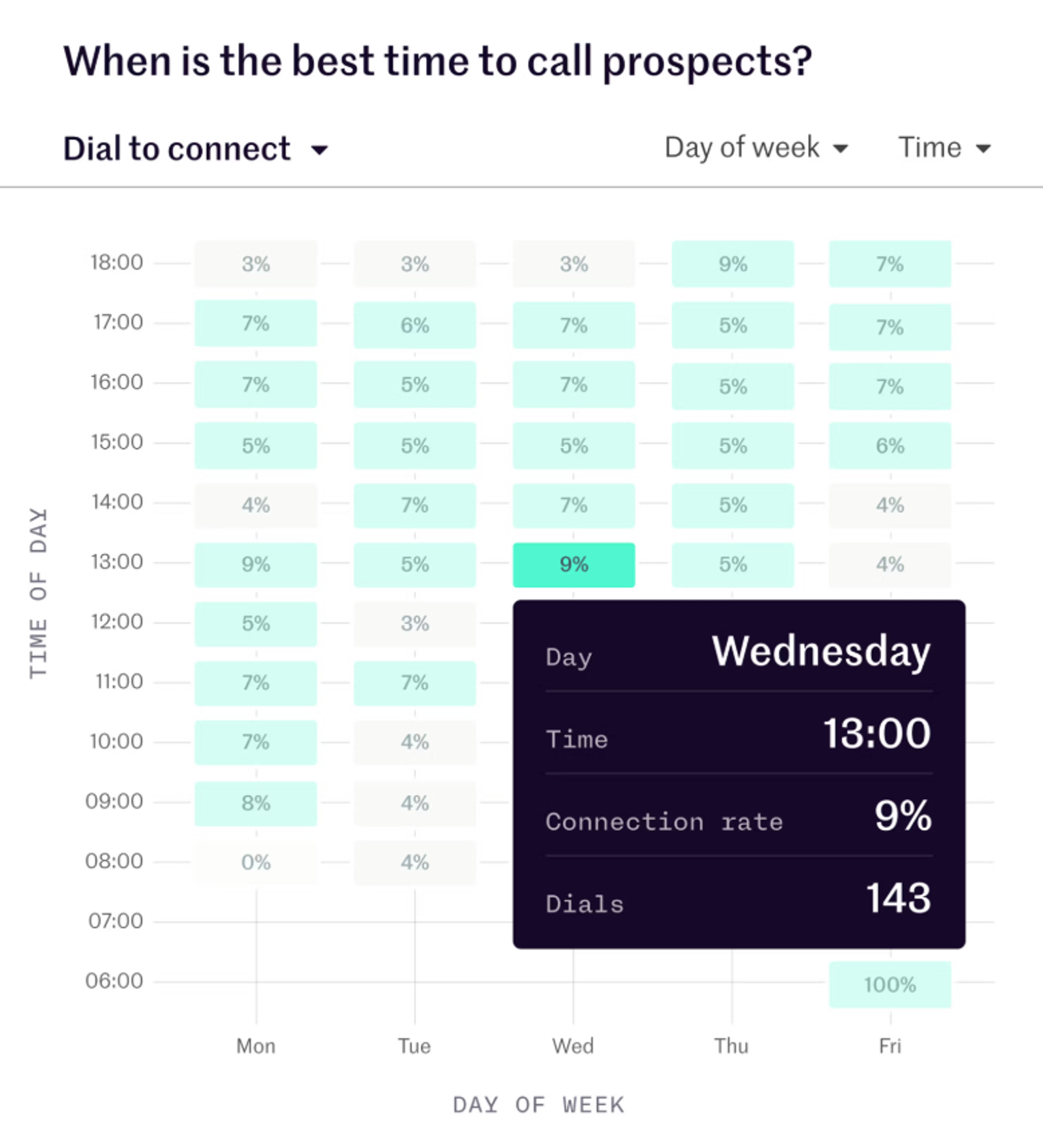
Key considerations for your AI-powered dialer
Your dialer needs to align with your specific sales and operational objectives.
Consider the following:
→If your team struggles with low connect rates:
Prioritize AI-driven call routing that filters out bad numbers and optimizes call timing.
→If your reps are spending too much time dialing manually:
Look for parallel dialing capabilities that automate outbound calling.
→If you need to scale outreach quickly without losing personalization:
Ensure your dialer integrates with your CRM for automated data capture and context-aware follow-ups.
By prioritizing solutions that both address specific pain points in your operations and support key sales targets, you can achieve the ROI you’re looking for.
You’ll also be able to build a stronger case as you seek buy-in for your preferred solution among key stakeholders like RevOps leaders and sales managers, who are focused on efficiency, and CROs, who need to see measurable pipeline growth.
Step 2: Use AI-driven analytics to refine talk tracks and improve rep performance
Once your team is consistently connecting with prospects, the next challenge is to ensure those conversations lead to booked meetings. AI-powered analytics help you and your teams identify what’s effective, where conversations stall, and how to improve outcomes.
At a basic level, AI-driven call analytics work by:
- Tracking patterns in successful vs. unsuccessful calls—showing how top reps structure their conversations and where lower-performing reps lose engagement
- Surfacing common objections and response effectiveness—analyzing when prospects push back and how reps handle it
- Analyzing conversation balance and talk speed—highlighting when reps talk too much, rush through key points, or miss opportunities to pause for engagement.
AI doesn’t replace training or coaching—but it makes it easier to identify coaching opportunities based on real call data rather than relying on assumptions or scattered rep feedback.
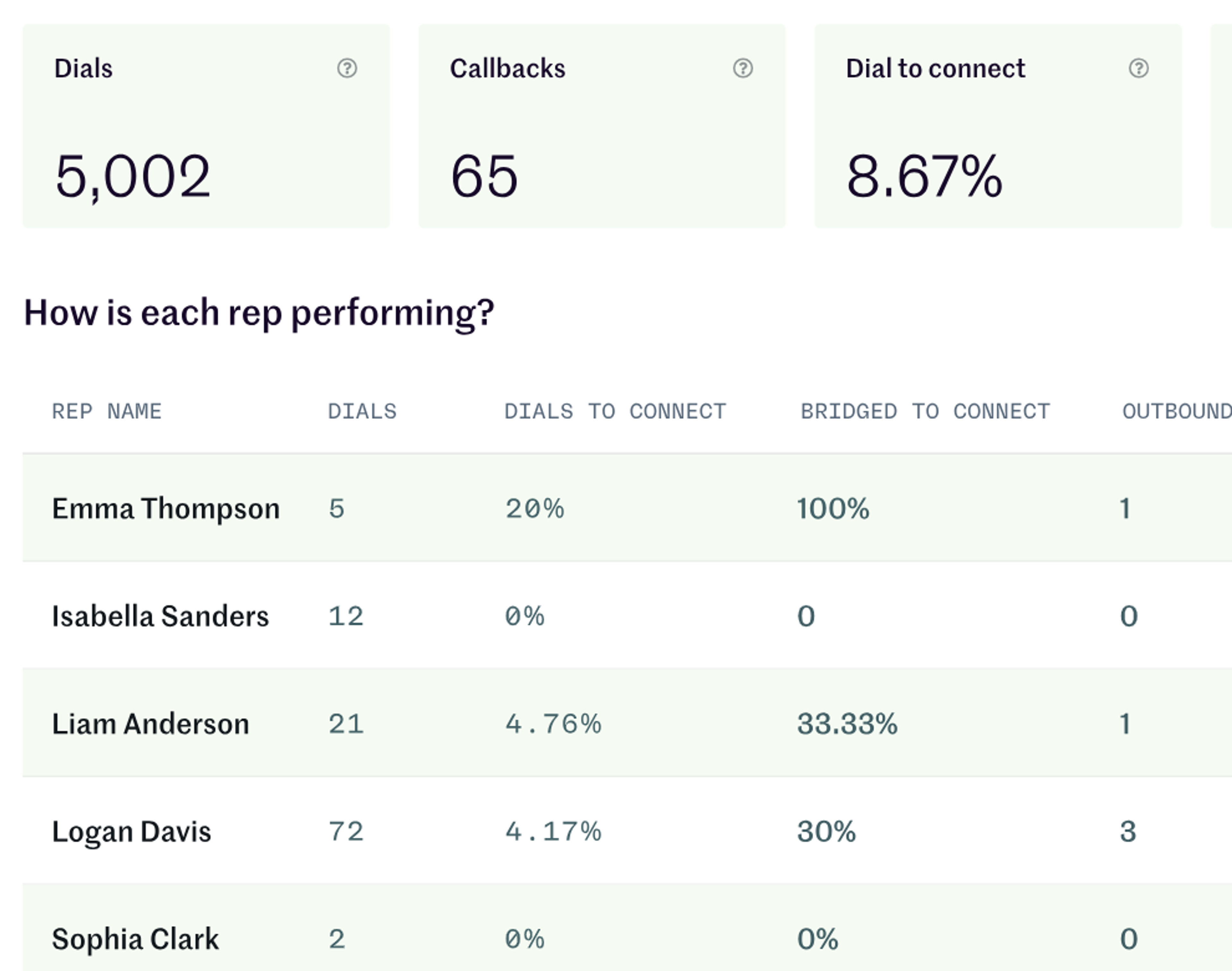
Here’s a look at how AI analytics work in practice
Imagine you’re reviewing performance data from your SDR team in Orum. You notice that one of your reps is consistently losing prospects after discussing pricing.
Instead of relying on anecdotal feedback, Orum’s AI surfaces key call moments—flagging where conversations break down so you can review them instantly.
Listening back to calls within Orum’s call library, you immediately spot the issue: They introduce pricing too early in the conversation before fully establishing value. You compare their approach with high-performing reps—who take time to position ROI before discussing costs—and see how prospects respond differently.
This approach allows you to:
✅Pinpoint exactly where conversations fail instead of guessing why deals aren’t moving forward
✅ Show your rep real examples of successful objection handling rather than just giving generic advice
✅ Make coaching data-driven—you’re not just telling reps what to do, you’re showing them how successful conversations unfold and where they can improve based on real performance insights
Rather than hoping for improvement, you have a structured way to refine talk tracks, adjust sales coaching, and impact pipeline growth.
Step 3: Integrate AI with your CRM for seamless workflows
Optimizing dials and refining talk tracks are only part of the equation—AI-powered cold calling is most effective when it seamlessly integrates with your CRM. Without integration, reps waste time on manual data entry, managers lack visibility into pipeline activity, and event follow-ups become inconsistent.
AI-driven CRM integration solves these problems by:
- Automating call logging so reps can focus on conversations instead of admin work
- Syncing call data in real-time, so full prospect history is available for every interaction
- Triggering follow-up actions based on call outcomes, which keeps engagement structured and efficient
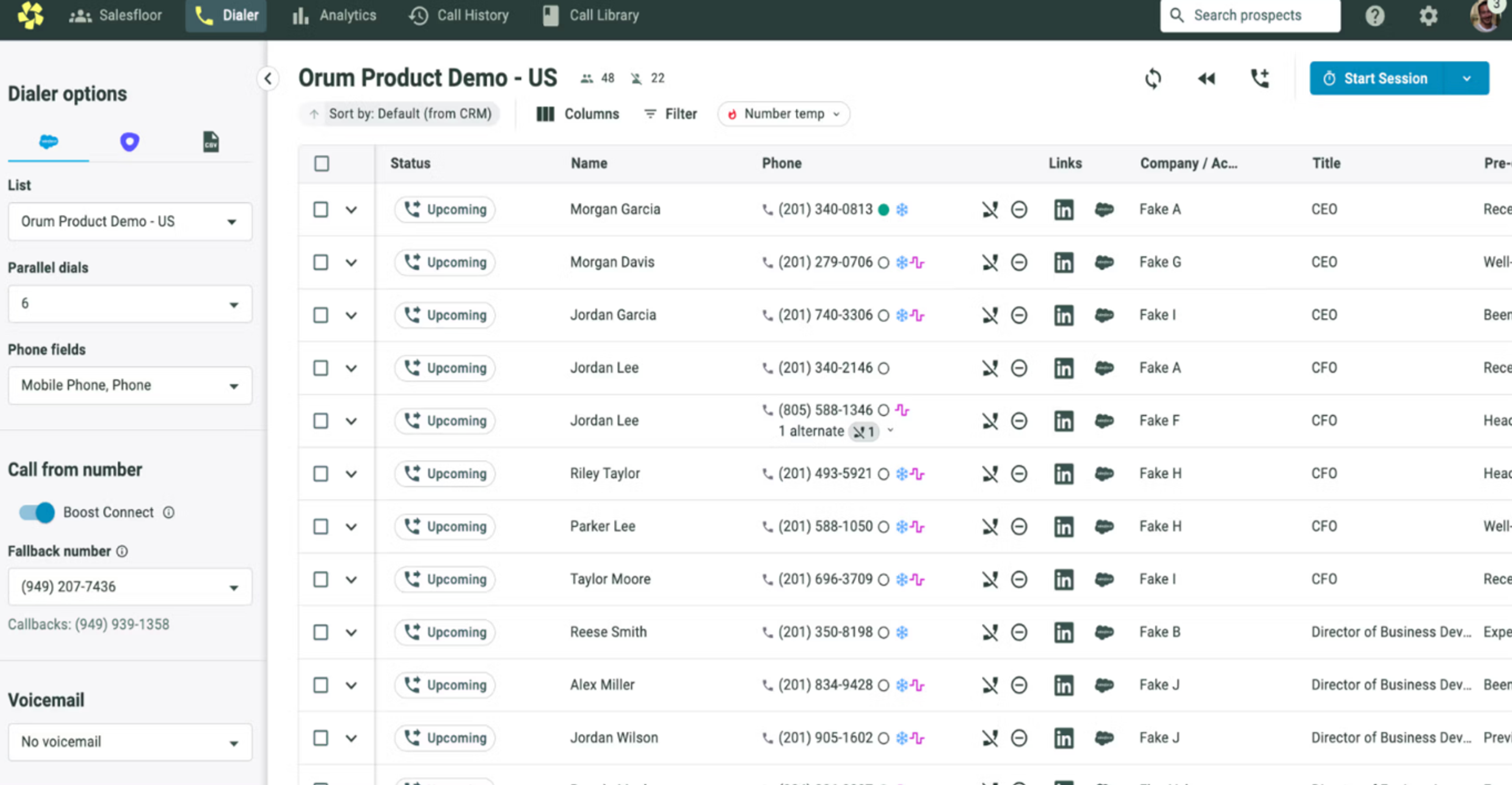
How Orum automates CRM workflows
Let’s say a rep makes a call using Orum, and the prospect requests a follow-up next week. Instead of the rep manually logging the interaction and setting reminders, Orum:
1️⃣ Automatically records the call outcome in Salesforce or HubSpot, ensuring the data is stored instantly
2️⃣ Syncs the prospect’s engagement history, allowing the rep to see past conversations before the next call
3️⃣ Ensures call data is logged in the CRM, allowing follow-up workflows to be triggered automatically based on the rep’s workflow settings
Now, instead of your sales team having to update records or remember next steps, AI keeps everything organized—which means your reps stay focused on building relationships and selling.
In summary, an AI-CRM integration provides you with:
- A centralized view of rep activity—every call, outcome, and next step is documented automatically
- Faster response times—prospects don’t fall through the cracks due to missed follow-ups
- More accurate reporting—pipeline insights are based on real-time data, not rep memory
For RevOps leaders and VPs of Sales, this means better forecasting, cleaner data, and a more predictable sales process.
Best practices for leveraging AI in cold calling
Integrating AI into cold calling isn’t just about choosing the right tools—it’s about making sure your team adopts AI effectively, balances automation with real conversations, and continuously refines their approach.
Here’s how to get the most out of AI-powered sales workflows.
Train your team to use AI effectively
Even the best AI-powered tools won’t drive results if reps don’t know how to use them properly. AI should make their workflow easier—not feel like another system to manage. Training should focus on:
- How AI fits into their day-to-day workflow—so it feels seamless rather than disruptive
- Understanding AI insights—helping reps apply data-backed recommendations rather than just receiving raw analytics
- Encouraging adoption through ease of use—the best AI solutions are intuitive, but reps still need to see clear benefits upfront
Sales leaders should prioritize tools that integrate directly into existing processes so reps can focus on selling, not figuring out new AI sales software.
Balance automation with human touch and experiences
AI should enhance conversations, not replace them. While AI speeds up dialing and refines talk tracks, prospects still want to connect with a real person who understands their challenges.
The key is combining automation with peer learning and real-time sales interactions. Tools like Orum’s call library and salesfloor help reps:
- Learn from top-performing peers—listening to successful calls instead of relying on scripted playbooks
- Stay motivated in a dynamic sales environment—feeling connected to the team, even when making high-volume dials
- Fine-tune messaging in real-time—adjusting their approach based on real conversations, not just AI recommendations
By keeping reps engaged in both AI-driven efficiency and live sales coaching, teams strike the right balance between scalability and personalization.
Track performance and optimize strategies
AI-driven sales isn’t a one-time setup—it’s a continuous process of testing, learning, and refining. Sales leaders should establish a structured feedback loop to ensure AI insights translate into real performance gains.
Here’s how to create an effective AI-driven feedback loop:
- Collect and analyze AI-driven insights
- Use call analytics to identify which talk tracks lead to conversions.
- Review patterns in objections and how reps handle them.
- Track rep performance over time to measure improvement areas. - Hold regular coaching sessions based on data
- Instead of generic coaching, use real examples from AI-flagged calls.
- Compare top-performing reps’ conversations with struggling reps to highlight differences.
- Provide actionable recommendations backed by AI-driven insights. - Test and iterate based on real-world outcomes
- Adjust scripts and outreach strategies based on conversion data.
- Optimize call timing and follow-up cadences based on AI recommendations.
- Continuously refine objection-handling techniques as new insights emerge. - Create a culture of peer learning and collaboration
- Encourage reps to share successful calls from the call library.
- Use AI-powered salesfloor analytics to keep the team motivated and engaged.
- Reinforce learning through real-time feedback loops, not just periodic reviews.
With this approach, AI insights aren’t just passive data—they become an active part of coaching, iteration, and long-term sales strategy.
How Centime implemented AI cold calling to increase productivity and pipeline efficiency
Centime, a B2B fintech company, turned to Orum’s AI-powered cold-calling solutions to eliminate inefficiencies, increase live conversations, and improve sales productivity.
Here’s how they did it.
Too much time spent on manual dialing, not enough live conversations
Centime’s sales team faced a bottleneck in outbound prospecting—reps were spending too much time manually dialing, navigating voicemails, and logging call data.
This inefficiency limited the number of live conversations reps could have daily, ultimately slowing down pipeline growth.
Automating outbound calls and streamlining workflows with Orum
To increase efficiency and scale outreach, Centime implemented Orum’s AI-powered parallel dialer to:
- Eliminate time spent on unanswered calls by connecting reps only when a real person answers
- Automate call logging and CRM syncing to reduce manual admin work
- Give managers visibility into call data and rep performance with real-time analytics
More live conversations, higher productivity, and a stronger pipeline
With Orum, Centime’s team significantly increased live connect rates and reduced rep downtime. More conversations per hour meant faster pipeline growth and improved overall sales efficiency.
Read the full case study here: Centime’s AI-powered sales transformation
Making AI-powered cold calling work for your sales team
AI cold calling helps sales teams connect with more prospects, personalize outreach at scale, and continuously improve performance.
When you effectively integrate the right solution, you’ll reduce rep downtime, provide your sales teams with actionable insights, and back every call with relevant data.
To get the most out of AI-driven sales:
- Choose the right AI-powered dialer to maximize connect rates
- Use AI analytics to refine talk tracks and coaching
- Integrate AI with your CRM for seamless workflows
Sales teams that leverage AI strategically don’t just increase efficiency—they build a smarter, more scalable outbound process that drives real pipeline growth. Now is the time to start optimizing.
Use AI to increase pick-up rates, automate tasks, and enhance call quality.
Get your reps into more conversations with Orum’s AI dialing platform.
